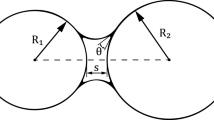Abstract
We propose a real time simulation for window frost formation on mobile devices that uses both particles and grids. Previous ice formation methods made heavy demands on both memory and computational capacity because they were designed for a desktop environment. In this paper, a frost skeleton grows around a location touched by the user using particles, and the ice surfaces are constructed using a grid. Using a nonlattice random-walk technique, the frost skeleton grows freely and naturally. A hash grid technique is used to search efficiently for neighbor particles during the crystallization process. Finally, some 2.5D details are added to the ice skeleton by adjusting the height of the grid vertices around the skeleton. Experiments show that our method creates realistic frost in real time. Our method can be used to express ice formation effects in touch-based mobile device applications such as weather forecasts or games.









Similar content being viewed by others
References
Carte AE (1961) Air bubbles in ice. Proc Phys Soc 77(3):757. http://stacks.iop.org/0370-1328/77/i=3/a=327
Festenberg NV, Gumhold S (2011) Diffusion-based snow cover generation. Comput Graphics Forum 30(6):1837–1849. doi:10.1111/j.1467-8659.2011.01904.x
Gagnon J, Paquette E (2011) Procedural and interactive icicle modeling. Vis Comput 27(6):451–461. doi:10.1007/s00371-011-0584-9
Grinstein G, Mazenko G (1986) Directions in condensed matter physics: memorial volume in honor of Shang-keng Ma, vol 1. World Scientific
Im J, Park H, Kim JH, Kim CH (2013) A particle-grid method for opaque ice formation. Comput Graphics Forum 32(2pt3):371–377. doi:10.1111/cgf.12057
Ishikawa T, Dobashi Y, Yue Y, Kakimoto M, Watanabe T, Kondo K, Iwasaki K, Nishita T (2013) Visual simulation of glazed frost. In: ACM SIGGRAPH 2013 Posters, SIGGRAPH ’13. ACM, New York, pp 14:1–14:1. doi:10.1145/2503385.2503400
Iwasaki K, Uchida H, Dobashi Y, Nishita T (2010) Fast particle-based visual simulation of ice melting. Comput Graphics Forum 29(7):2215–2223. doi:10.1111/j.1467-8659.2010.01810.x
Kamal K, Kaykobad M (2008) Generation of mountain ranges by modifying a controlled terrain generation approach. In: 11th international conference on computer and information technology, 2008. ICCIT 2008. pp 527–532, doi:10.1109/ICCITECHN.2008.4803058
Kharitonsky D, Gonczarowski J (1993) A physically based model for icicle growth. Vis Comput 10(2):88–100. doi:10.1007/BF01901945
Kim T, Henson M, Lin MC (2004) A hybrid algorithm for modeling ice formation. In: Proceedings of the 2004 ACM SIGGRAPH/eurographics symposium on computer animation, SCA ’04. Eurographics Association, Aire-la-Ville, Switzerland, pp 305–314. doi:10.1145/1028523.1028564
Kim T, Adalsteinsson D, Lin MC (2006) Modeling ice dynamics as a thin-film stefan problem. In: Proceedings of the 2006 ACM SIGGRAPH/eurographics symposium on computer animation, SCA ’06. Eurographics Association, Aire-la-Ville, Switzerland, pp 167–176. http://dl.acm.org/citation.cfm?id=1218064.1218087
Madrazo C, Tsuchiya T, Sawano H, Koyanagi K (2009) Air bubbles in ice by simulating freezing phenomenon. The Journal of the Society for Art and Science 8(1):35–42
Marechal N, Guerin E, Galin E, Merillou S, Merillou N (2010) Heat transfer simulation for modeling realistic winter sceneries. Comput Graphics Forum 29(2):449–458. doi:10.1111/j.1467-8659.2009.01614.x
Meakin P (1983) Diffusion-controlled cluster formation in two, three, and four dimensions. Phys. Rev. A 27:604–607. doi:10.1103/PhysRevA.27.604
Miao Y, Xiao S (2015) Particle-based ice freezing simulation. In: Proceedings of the 14th ACM SIGGRAPH international conference on virtual reality continuum and its applications in industry, VRCAI ’15. ACM, New York, pp 17–22. doi:10.1145/2817675.2817676
Müller M, Charypar D, Gross M (2003) Particle-based fluid simulation for interactive applications. In: Proceedings of the 2003 ACM SIGGRAPH/eurographics symposium on computer animation. Eurographics Association, pp 154–159
Nishino T, Iwasaki K, Dobashi Y, Nishita T (2012) Visual simulation of freezing ice with air bubbles. In: SIGGRAPH asia 2012 technical briefs, SA ’12. ACM, New York, pp 1:1–1:4. doi:10.1145/2407746.2407747
Reynolds DT, Laycock SD, Day AM (2014) Real-time accumulation of occlusion-based snow. Vis Comput 31(5):689–700. doi:10.1007/s00371-014-0995-5
Seipel S, Nivfors A (2007) Real-time rendering of ice. In: Proceedings of the ninth IASTED international conference on computer graphics and imaging, CGIM ’07. ACTA Press, Anaheim, pp 60–66. http://dl.acm.org/citation.cfm?id=1710707.1710719
Stam J (1999) Stable fluids. In: Proceedings of the 26th annual conference on computer graphics and interactive techniques, SIGGRAPH ’99. ACM Press/Addison-Wesley Publishing Co., New York, pp 121–128. doi:10.1145/311535.311548
Stanton M, Humberston B, Kase B, O’Brien JF, Fatahalian K, Treuille A (2014) Self-refining games using player analytics. ACM Trans Graph 33(4):73:1–73:9. doi:10.1145/2601097.2601196
Stomakhin A, Schroeder C, Chai L, Teran J, Selle A (2013) A material point method for snow simulation. ACM Trans Graph 32(4):102:1–102:10. doi:10.1145/2461912.2461948
Witten TA, Sander LM (1981) Diffusion-limited aggregation, a kinetic critical phenomenon. Phys Rev Lett 47:1400–1403. doi:10.1103/PhysRevLett.47.1400
Zhu Y, Bridson R (2005) Animating sand as a fluid. In: ACM SIGGRAPH 2005 Papers, SIGGRAPH ’05. ACM, New York, pp 965–972. doi:10.1145/1186822.1073298
Acknowledgements
This research was supported by Basic Science Research Program through the National Research Foundation of Korea (NRF), funded by the Ministry of Education, Science, ICT and Future Planning (NRF-2017R1A2B2005380) and Institute for Information & Communications Technology Promotion (IITP) grant funded by the Korea government (MSIP; 2016-0-00285, High performance computing [HPC] based rendering solution development) and Korea Creative Content Agency(KOCCA) grant funded by the Korea government(MCST) (2015-0-00060, Developing the technology of open composable content editors for realistic media) and Business for Cooperative R&D between Industry, Academy, and Research Institute funded P Korea Small and Medium Business Administration (Grant C0443008).
Author information
Authors and Affiliations
Corresponding author
Rights and permissions
About this article
Cite this article
Im, J., Choi, M., Lee, J. et al. An optimized real time algorithm for window frost formation suited to mobile devices. Multimed Tools Appl 77, 11807–11821 (2018). https://doi.org/10.1007/s11042-017-4819-2
Received:
Revised:
Accepted:
Published:
Issue Date:
DOI: https://doi.org/10.1007/s11042-017-4819-2




